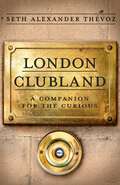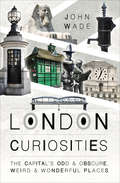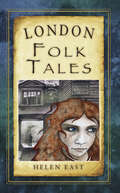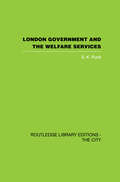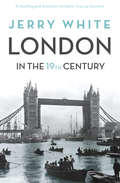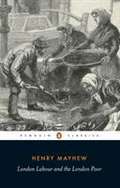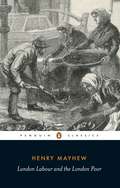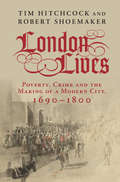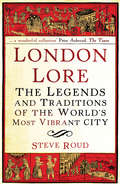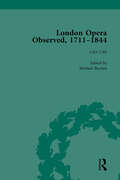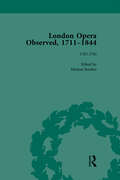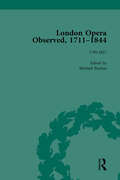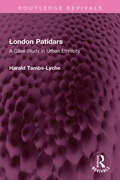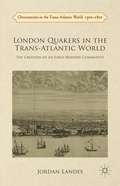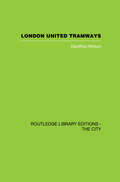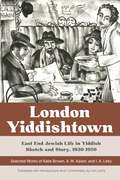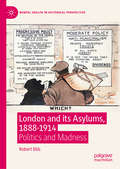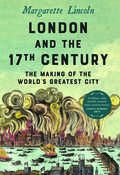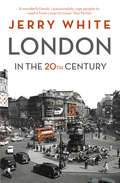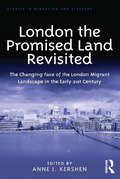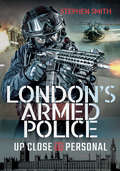- Table View
- List View
London
by Robert O. Bucholz Joseph P. WardBetween 1550 and 1750 London became the greatest city in Europe and one of the most vibrant economic and cultural centres in the world. This book is a history of London during this crucial period of its rise to world-wide prominence, during which it dominated the economic, political, social and cultural life of the British Isles, as never before nor since. London incorporates the best recent work in urban history, contemporary accounts from Londoners and tourists, and fictional works featuring the city in order to trace London's rise and explore its role as a harbinger of modernity, while examining how its citizens coped with those achievements. London covers the full range of life in London, from the splendid galleries of Whitehall to the damp and sooty alleyways of the East End. Readers will brave the dangers of plague and fire, witness the spectacles of the Lord Mayor's Pageant and the hangings at Tyburn, and take refreshment in the city's pleasure-gardens, coffee-houses and taverns.
London Clubland: A Companion for the Curious
by Seth Alexander ThévozStep into the hidden world of London's private members' clubs with London Clubland: A Companion for the Curious. This guide, by the leading historian on the subject, offers a fascinating insight into these legendary institutions. Culture, history and traditions are all explained - from aristocratic haunts like Boodle's and Brooks's, to modern icons like Soho House and the Groucho Club.Insightful and entertaining, London Clubland is your ultimate guide and almanac to this world, from navigating the application process, to the unwritten rules that define these spaces - not to mention a wealth of trivia assembled over twenty years. Readers will discover mottos, maps, songs and club recipes, as well as little-known facts that some of London's most iconic clubs probably wouldn't want you to know.Whether you are a long-standing member, a reciprocal visitor, an aspiring applicant, or simply just curious about this secretive world, London Clubland offers an engaging and revealing tour through some of London's most discreet institutions.
London Clubland: A Companion for the Curious
by Seth Alexander ThévozStep into the hidden world of London's private members' clubs with London Clubland: A Companion for the Curious. This guide, by the leading historian on the subject, offers a fascinating insight into these legendary institutions. Culture, history and traditions are all explained - from aristocratic haunts like Boodle's and Brooks's, to modern icons like Soho House and the Groucho Club.Insightful and entertaining, London Clubland is your ultimate guide and almanac to this world, from navigating the application process, to the unwritten rules that define these spaces - not to mention a wealth of trivia assembled over twenty years. Readers will discover mottos, maps, songs and club recipes, as well as little-known facts that some of London's most iconic clubs probably wouldn't want you to know.Whether you are a long-standing member, a reciprocal visitor, an aspiring applicant, or simply just curious about this secretive world, London Clubland offers an engaging and revealing tour through some of London's most discreet institutions.
London Curiosities: The Capital's Odd & Obscure, Weird & Wonderful Places
by John WadeLondon is full of curiosities. Who knew that beneath the Albert Memorial lies a chamber resembling a church crypt? Or that there are catacombs under Camden? Who would expect to find a lighthouse in East London, sphinxes in South London, dummy houses in West London, or a huge bust of film director Alfred Hitchcock in North London? <p><p> How many of those who walk past Cleopatra’s Needle pause to consider why a 3,000-year-old Egyptian monument stands beside the Thames? How many know that what was once London’s smallest police station can be seen in Trafalgar Square? Or that pineapples are used in the architectural design of so many buildings? Or why there are memorials to the Mayflower and Pilgrim Fathers in Rotherhithe? Learn more about the capital of curiosities in this delightful guide for lovers of history, trivia, and travel.
London Folk Tales (Folk Tales: United Kingdom)
by Helen EastLondon is a world unto itself; an outrageous, quirky and diverse microcosm where all walks of life cross paths, their languages jostling and mingling – and there are tales whichever way you turn. Now thirty of the best, drawn from oral history and newly recorded local reminiscence, as well as folk sources and written texts, have been brought to life by a mistress of storytelling. Here you will find Dick Whittington alongside the patron saint of cobblers, a royal rat rubbing shoulders with the Maid Uncumber, and fish that decide destinies. Revisit old friends and discover new ones in this wonderful selection of London folk tales – as light and dark, and as full of unexpected twists, as the streets of London itself.
London In The Nineteenth Century: 'A Human Awful Wonder of God'
by Jerry WhiteJerry White's London in the Nineteenth Century is the richest and most absorbing account of the city's greatest century by its leading expert.London in the nineteenth century was the greatest city mankind had ever seen. Its growth was stupendous. Its wealth was dazzling. Its horrors shocked the world. This was the London of Blake, Thackeray and Mayhew, of Nash, Faraday and Disraeli. Most of all it was the London of Dickens. As William Blake put it, London was 'a Human awful wonder of God'.In Jerry White's dazzling history we witness the city's unparalleled metamorphosis over the course of the century through the daily lives of its inhabitants. We see how Londoners worked, played, and adapted to the demands of the metropolis during this century of dizzying change. The result is a panorama teeming with life.
London Labour And The London Poor (Classics Series)
by Henry Mayhew Victor E. NeuburgLondon Labour and the London Poor originated in a series of articles, later published in four volumes, written for the Morning Chronicle in 1849 and 1850 when journalist Henry Mayhew was at the height of his career. Mayhew aimed simply to report the realities of the poor from a compassionate and practical outlook. This penetrating selection shows how well he succeeded: the underprivileged of London become extraordinarily and often shockingly alive. For more than seventy years, Penguin has been the leading publisher of classic literature in the English-speaking world. With more than 1,700 titles, Penguin Classics represents a global bookshelf of the best works throughout history and across genres and disciplines. Readers trust the series to provide authoritative texts enhanced by introductions and notes by distinguished scholars and contemporary authors, as well as up-to-date translations by award-winning translators.
London Labour and the London Poor: A Cyclopædia Of The Condition And Earnings Of Those That Will Work, Those That Cannot Work, And Those That Will Not (London Labour And The London Poor - 4-volume Set Ser.)
by Henry MayhewLondon Labour and the London Poor originated in a series of newspaper articles written by the great journalist Henry Mayhew between 1849 and 1850. A dozen years later, it had grown into the fullest picture we have of labouring people in the world's greatest city in the nineteenth century: a four volume account of the hopes, customs, grievances and habits of the working-classes that allows them to tell their own stories. Combining practicality with compassion, Mayhew worked unencumbered by political theory and strove solely to report on the lives of the London poor, their occupations and trades. This selection shows how well he succeeded. From costermongers to ex-convicts, from chimney-sweeps to vagrants, the underprivileged of London are uniquely brought to life - their plight expressed through a startling blend of first person accounts, Mayhew's perceptions, and sharp statistics.
London Lives
by Tim Hitchcock Robert ShoemakerLondon Lives is a fascinating new study which exposes, for the first time, the lesser-known experiences of eighteenth-century thieves, paupers, prostitutes and highwaymen. It charts the experiences of hundreds of thousands of Londoners who found themselves submerged in poverty or prosecuted for crime, and surveys their responses to illustrate the extent to which plebeian Londoners influenced the pace and direction of social policy. Calling upon a new body of evidence, the book illuminates the lives of prison escapees, expert manipulators of the poor relief system, celebrity highwaymen, lone mothers and vagrants, revealing how they each played the system to the best of their ability in order to survive in their various circumstances of misfortune. In their acts of desperation, the authors argue that the poor and criminal exercised a profound and effective form of agency that changed the system itself, and shaped the evolution of the modern state.
London Lore: The legends and traditions of the world's most vibrant city
by Steve RoudIn which part of North London were wild beasts once thought to roam the sewers? Why did 1920s working-class Londoners wear necklaces of blue beads?Who was the original inspiration for the 'pearly king' costume?And did Spring-heeled Jack, scourge of Victorian London, ever really exist?Exploring everything from local superstitions and ghost stories to annual customs, this is an enchanting guide to the ancient legends and deep-rooted beliefs that can be found the length and breadth of the city.
London Opera Observed 1711-1844, Volume II: 1763-1782
by Michael BurdenThe thrust of these five volumes is contained in their title, London Opera Observ’d. It takes its cue from the numerous texts and volumes which — during the seventeenth, eighteenth and nineteenth centuries — used the concept of ‘spying’ or ‘observing’ by a narrator, or rambler, as a means of establishing a discourse on aspects of London life. The material in this five-volume reset edition examines opera not simply as a genre of performance, but as a wider topic of comment and debate. The stories that surrounded the Italian opera singers illuminate contemporary British attitudes towards performance, sexuality and national identity. The collection includes only complete, published material organised chronologically so as to accurately retain the contexts in which the original readers encountered them — placing an emphasis on rare texts that have not been reproduced in modern editions. The aim of this collection is not to provide a history of opera in England but to facilitate the writing of them or to assist those wishing to study topics within the field. Headnotes and footnotes establish the publication information and provide an introduction to the piece, its author, and the events surrounding it or which caused its publication. The notes concentrate on attempting to identify those figures mentioned within the texts. The approach is one of presentation, not interpretation, ensuring that the collection occupies a position that is neutral rather than polemical.
London Opera Observed 1711-1844, Volume III: 1783-1792
by Michael BurdenThe thrust of these five volumes is contained in their title, London Opera Observ’d. It takes its cue from the numerous texts and volumes which — during the seventeenth, eighteenth and nineteenth centuries — used the concept of ‘spying’ or ‘observing’ by a narrator, or rambler, as a means of establishing a discourse on aspects of London life. The material in this five-volume reset edition examines opera not simply as a genre of performance, but as a wider topic of comment and debate. The stories that surrounded the Italian opera singers illuminate contemporary British attitudes towards performance, sexuality and national identity. The collection includes only complete, published material organised chronologically so as to accurately retain the contexts in which the original readers encountered them — placing an emphasis on rare texts that have not been reproduced in modern editions. The aim of this collection is not to provide a history of opera in England but to facilitate the writing of them or to assist those wishing to study topics within the field. Headnotes and footnotes establish the publication information and provide an introduction to the piece, its author, and the events surrounding it or which caused its publication. The notes concentrate on attempting to identify those figures mentioned within the texts. The approach is one of presentation, not interpretation, ensuring that the collection occupies a position that is neutral rather than polemical.
London Opera Observed 1711-1844, Volume IV: 1799-1821
by Michael BurdenThe thrust of these five volumes is contained in their title, London Opera Observ’d. It takes its cue from the numerous texts and volumes which — during the seventeenth, eighteenth and nineteenth centuries — used the concept of ‘spying’ or ‘observing’ by a narrator, or rambler, as a means of establishing a discourse on aspects of London life. The material in this five-volume reset edition examines opera not simply as a genre of performance, but as a wider topic of comment and debate. The stories that surrounded the Italian opera singers illuminate contemporary British attitudes towards performance, sexuality and national identity. The collection includes only complete, published material organised chronologically so as to accurately retain the contexts in which the original readers encountered them — placing an emphasis on rare texts that have not been reproduced in modern editions. The aim of this collection is not to provide a history of opera in England but to facilitate the writing of them or to assist those wishing to study topics within the field. Headnotes and footnotes establish the publication information and provide an introduction to the piece, its author, and the events surrounding it or which caused its publication. The notes concentrate on attempting to identify those figures mentioned within the texts. The approach is one of presentation, not interpretation, ensuring that the collection occupies a position that is neutral rather than polemical.
London Patidars: A Case Study in Urban Ethnicity (Routledge Revivals)
by Harald Tambs-LycheFirst Published in 1980, London Patidars presents the case study of the Patidars, a landowning caste from the Indian state of Gujarat, in London. Patidars being the landowning caste has taken over much of the ideology of the merchant castes. This ‘merchant ideal’ is a central part of their self-image. It is an incitement to initiative in business and to some extent their actual economic behaviour does reflect the ideal. But the cases studied do not all conform to this ideal, and they pose questions: How does this particular type of ethnic boundary relate to the opportunities of the individual Patidar? Why and how is this boundary maintained? Harald Tambs-Lyche concludes that the form given to the ethnic boundary is advantageous to many Patidars but not to all in the same degree. This raises problems which potentially could change the present pattern. Other potential problems relate to their relationship with the English. As successful merchants they risk becoming objects of envy like, formerly, the Jewish community. This book is a must read for scholars of ethnic and race relations and sociology.
London Quakers in the Trans-Atlantic World
by Jordan LandesThis book explores the Society of Friend's Atlantic presence through its creation and use of networks, including intellectual and theological exchange, and through the movement of people. It focuses on the establishment of trans-Atlantic Quaker networks and the crucial role London played in the creation of a Quaker community in the North Atlantic.
London Underground Serial Killer: The Life Of Kieran Kelly
by Geoff PlattThe full story of the life and times of Kieran Patrick Kelly, the London Underground Serial Killer, who wandered up and down the Northern Line of the London Underground between 1960 and 1983, pushing innocent people that he had never met under trains, and who finished up killing over thirty people. The book provides a full biography of Kelly, discussing the details of his crimes, his victims and his ability to evade justice; he managed to secure mistrials or acquittals in twenty-five trials before being eventually convicted and sentenced to die to prison, which he did in Durham, in 2001. It could be argued that Kelly is the most investigated serial killer in the history of the world. His murders were investigated as they occurred between 1953 and 1983; they were reinvestigated in 1983 and again in 2015. The author of this book played major roles in the two latter inquiries, conducting the entire inquiry in 1983 and acting as a consultant to the 2015 inquiry. More is known about Kelly than any other serial killer in history. He was arrested before he had finished killing, then murdered his cellmate in the police station and was interviewed by the author ten minutes after this final murder, before spending the next two years discussing his crimes and his motivations with the author. The end result is a truly unique insight into the mind of a serial killer!
London United Tramways: A History 1894-1933
by Geoffrey WilsonWith the twentieth century arrived the first electric tramcars in London. Thirty years later the first trolley buses arrived - along with a fleet of new trams that were the most modern of their day. This era was one of rapid change, rich in achievement adn personalities. Among the more colourful of the undertakings involved was London United, which introduced the first public service of electric tramcars in 1901 adn became one of the predecessors of the present London Transport. This is a study of this eventful period, relating the development of the tramway and trolleybus system to the changing social background. It contains a wealth of hitherto unpublished material, both factual and anecdotal, taken from contemporary newspaper and other accounts, and a remarkable collection of illustrations - 48 pages in all. It should be of interest not only to the transport enthusiast but also to the general reader interested in social history. This book was first published in 1971.
London Yiddishtown: East End Jewish Life in Yiddish Sketch and Story, 1930–1950: Selected Works of Katie Brown, A. M. Kaizer, and I. A. Lisky
by Katie Brown I. A. Lisky A. M. KaizerIn London Yiddishtown: East End Jewish Life in Yiddish Sketch and Story, 1930–1950, Vivi Lachs presents a selection of previously un-translated short stories and sketches by Katie Brown, A. M. Kaizer, and I. A. Lisky, for the general reader and academic alike. These intriguing and entertaining tales build a picture of a lively East-End community of the 30s and 40s struggling with political, religious, and community concerns. Lachs includes a new history of the Yiddish literary milieu and biographies of the writers, with information gleaned from articles, reviews, and obituaries published in London’s Yiddish daily newspapers and periodicals. Lisky’s impassioned stories concern the East End’s clashing ideologies of communism, Zionism, fascism, and Jewish class difference. He shows anti-fascist activism, political debate in a kosher café, East-End extras on a film set, and a hunger march by the unemployed. Kaizer’s witty and satirical tales explore philanthropy, upward mobility, synagogue politics, and competition between Zionist organizations. They expose the character and foibles of the community and make fun of foolish and hypocritical behavior. Brown’s often hilarious sketches address episodes of daily life, which highlight family shenanigans and generational misunderstandings, and point out how the different attachments to Jewish identity of the immigrant generation and their children created unresolvable fractures. Each section begins with a biography of the writer, before launching into the translated stories with contextual notes. London Yiddishtown offers a significant addition to the literature about London, about the East End, about Jewish history, and about Yiddish. The East End has parallels with New York’s Lower East Side, yet London’s comparatively small enclave, and the particular experience of London in the 1930s and the bombing of the East End during the Blitz make this history unique. It is a captivating read that will entice literary and history buffs of all backgrounds. A Yiddish Book Center Translation.
London and its Asylums, 1888-1914: Politics and Madness (Mental Health in Historical Perspective)
by Robert EllisThis book explores the impact that politics had on the management of mental health care at the turn of the nineteenth and twentieth centuries. 1888 and the introduction of the Local Government Act marked a turning point in which democratically elected bodies became responsible for the management of madness for the first time. With its focus on London in the period leading up to the First World War, it offers a new way to look at institutions and to consider their connections to wider issues that were facing the capital and the nation. The chapters that follow place London at the heart of international networks and debates relating to finance, welfare, architecture, scientific and medical initiatives, and the developing responses to immigrant populations. Overall, it shines a light on the relationships between mental health policies and other ideological priorities.
London and the Seventeenth Century: The Making of the World's Greatest City
by Margarette LincolnThe first comprehensive history of seventeenth-century London, told through the lives of those who experienced it The Gunpowder Plot, the Civil Wars, Charles I&’s execution, the Plague, the Great Fire, the Restoration, and then the Glorious Revolution: the seventeenth century was one of the most momentous times in the history of Britain, and Londoners took center stage. In this fascinating account, Margarette Lincoln charts the impact of national events on an ever-growing citizenry with its love of pageantry, spectacle, and enterprise. Lincoln looks at how religious, political, and financial tensions were fomented by commercial ambition, expansion, and hardship. In addition to events at court and parliament, she evokes the remarkable figures of the period, including Shakespeare, Bacon, Pepys, and Newton, and draws on diaries, letters, and wills to trace the untold stories of ordinary Londoners. Through their eyes, we see how the nation emerged from a turbulent century poised to become a great maritime power with London at its heart—the greatest city of its time.
London at War, 1939-1945
by Philip ZieglerIn 1939, London was not merely the greatest city in the world, it was the most tempting and vulnerable target for aerial attack. For six years it was in the front line of the free world’s battle against Fascism. It endured the horrors of the blitz of 1940 and 1941, the V1s, the V2s. Other cities suffered more intensely; no other city was so consistently under attack for so long a time. This is the story of London at war from 1939 to 1945, or perhaps of Londoners at war--for Philip Ziegler, best known as a biographer, is above all fascinated by the people who found their lives so suddenly and violently transformed: the querulous, tiresome, yet strangely gallant housewife from West Hampstead; the turbulent, left-wing, retired schoolmaster from Walthamstow, always standing up to the authorities; the odiously snobbish middle-class woman from Kensington, sneering at the 'scum' who took shelter in the Underground; the typist from Fulham; the plumber from Woolwich. It was their war every bit as much as it was Churchill’s or the King’s, and this is their story. Through a wealth of interviews and unpublished letters and diaries, as well as innumerable books and newspapers, the author has built up a dazzling portrait of an entire population under siege. There were cowards, there were criminals, there were incompetents, but what emerges from these pages is above all a record, in story after story, of astonishing patience, dignity and humour. 'I hope,' Ziegler writes, 'we will never have to endure again what they went through between 1939 and 1945. I hope, if we did, that we would conduct ourselves as well.'
London in the Twentieth Century: A City and Its People
by Jerry WhiteJerry White's London in the Twentieth Century, Winner of the Wolfson Prize, is a masterful account of the city’s most tumultuous century by its leading expert.In 1901 no other city matched London in size, wealth and grandeur. Yet it was also a city where poverty and disease were rife. For its inhabitants, such contradictions and diversity were the defining experience of the next century of dazzling change.In the worlds of work and popular culture, politics and crime, through war, immigration and sexual revolution, Jerry White’s richly detailed and captivating history shows how the city shaped their lives and how it in turn was shaped by them.
London the Promised Land Revisited: The Changing Face of the London Migrant Landscape in the Early 21st Century (Studies in Migration and Diaspora)
by Anne J. KershenSome two decades since the publication of London the Promised Land?, which charted and investigated the successes and failures of the migrant experience in London over a period of three hundred years, this book re-examines the migrant landscape in London. While remaining a beacon for immigrants, the migrant face of the city has changed rapidly and dramatically from one which was heavily populated by semi-skilled and unskilled post-colonial incomers, to one which now embraces the EU Accession Countries, refugees from the Middle East and Africa, oligarchs from Russia, the new wealthy from China, economic migrants from Latin America and Ireland, and still, post-colonial immigrants - at the same time witnessing the exodus ’home’ of incomers, or their descendants, who now see opportunities where there were none before. The contributors, all leading academics and practitioners in their diverse fields, examine changes to the migrant landscape of contemporary London at the micro, meso and macro levels. London the Promised Land Revisited thus explores a range of experiences in the capital, including the presence and treatment of illness amongst migrants, the phenomenon of migrant ’invisibility’ and asylum, the migrant marketplace and ethnic ’clustering’, and interaction with local and national government - across a variety of migrant groups, both ’new’ and ’old’. As such, this book will appeal to scholars across the social sciences with interest in migration, migrant experiences and the contemporary ’global’ city.
London's Armed Police: Up Close and Personal
by Stephen SmithAn insider&’s account of an elite unit fighting crime and terror on the streets of London—includes hundreds of photos. In this book, veteran firearms officer Stephen Smith goes behind the scenes of the Metropolitan Police&’s Specialist Firearms Unit, CO19—covering a wide range of events in recent history, from the controversial shootings of Azelle Rodney in 2005 and Mark Duggan in 2011 to the terrorist attacks on Westminster, London Bridge and Borough Market, as well as stories from decades past. Through his unique access to CO19, Smith has managed to put together hundreds of detailed photographs, both historical and contemporary, along with text that goes a long way to explain why it is necessary to have such an elite firearms unit on standby 24/7 in London. This comprehensive volume will bring you up-to date with the training, operations, equipment, and mindset of these courageous individuals who put their lives on the line on a daily basis to keep London safe.

